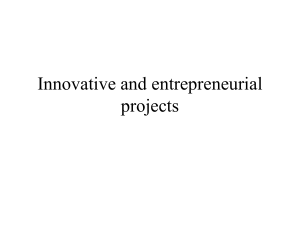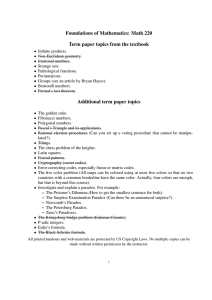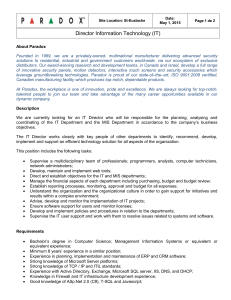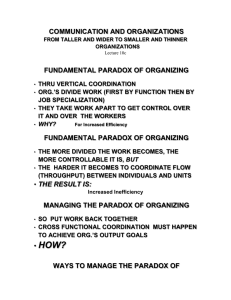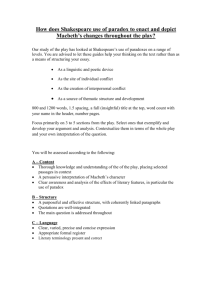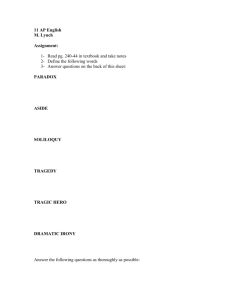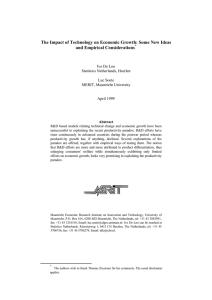at the beginning of the seminar. Use the standardised cover form!!!
advertisement
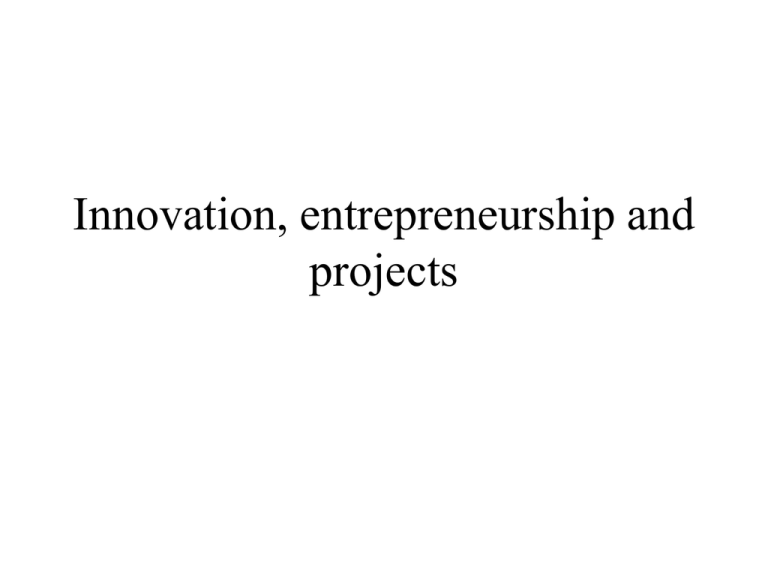
Innovation, entrepreneurship and projects Innovation …the process of bringing any new problem solving idea into use … it is the generation, implementation and acceptance of new ideas Incremental or Radical Proactive (Push) –Serendipity –Creativity Reactive (Pull) –Goal –Problem Phases • Initiation (Birth of an idea) • Investigation • Implementation • Stabilisation (Successful development) Birth of an idea - creativity • • • • • • • • • Diverse information service Staff with diverse interests Supportive management Failures willingly tolerated Freedom to pursue own ideas Success recognized Suggestion programmes Patent programmes Nonconformity tolerated • • • • • • • • • Risk taking encouraged Adequate resources Good strategic direction Free information exchange Brainstorming encouraged Access to external stimuli Non-constraining environment Technically competent team Challenging environment Succesfull development • • • • • • • • • Adequate funding Adequate personnel Management belief in project Risk-taking encouraged Strong project champion Senior project champion Strong project leader Good project selection process Good source of project ideas • • • • • • • • • Aligned to company objectives Clear project objectives Full-time team members Enthusiastic co-operative team Empowered team Use of external expertise Users’ needs understood Good contact with users Thorough development Roles in innovation • • • • • • • Initiator (Idea Champions) Investigator Feasibility Leader Project Leader Project Team Senior Manager (Sponsor) Consultant (Change Agent) Resistance to innovation Organizational Resistance – organisational structure – narrow focus of change – group inertia – threatened expertise – power resources – influence Who said you could work on this? Individual Resistance – habit – selective perception – economic factors – insecurity – social factors – lack of understanding Can you define your product or service and give us a three year projection within +/- 10%? What's the return on investment? Why should we attack that market, and if we do, what happens to our existing products? Your feasability study is not made in the standardised format The innovation paradox …the more your firm pays attention to innovation, the less likely it will be to be successful at innovation… …the culture and bureaucracy of your organization identifies an external intruder that has not aligned itself with the organization and function of the rest of the body, and tries to force the innovation program or capability to adopt the decision making processes, risk tolerances, timeframes, perspectives and "best practices" that are part and parcel of the rest of the organization… Readings • Nobelius: Towards the sixth generation of R&D management • Chiesa: Global R&D project management taxonomy Discussion questions for April 19th • • • • • • • Each group shall make short summaries of the literature and be prepared to present this summary in class (about 4 pages). This especially applies to Chiesa’s article that shall be summarised in 10 bullet points. Nobelius present paradigms of innovation work in terms of different generations and patterns. For each generation, state the main characteristics of projects belonging to that generation. For each step between generations (for example, the step from gen 3 to gen 4), what are the main advantages and the main problems appearing? For each of the generations, what is the five main characteristics that you want from a project manager? Nobelius speake about six generations. Which one will be the 7th? HOW CAN THE INNOVATION PARADOX BE AVOIDED? WHAT IS THE ROLE OF STANDARDISED PROJECT MANAGEMENT METHODS IN THE INNOVATION PARADOX? All summaries and answers/reflections to questions shall be handed over to Johann in paper format at the beginning of the seminar. Use the standardised cover form!!! Avoiding the innovation paradox? • What can the management do to avoid the paradox, i.e. how can they organize innovation projects in a way that preserves creativity and openness? • Presented as concise advice to managers
